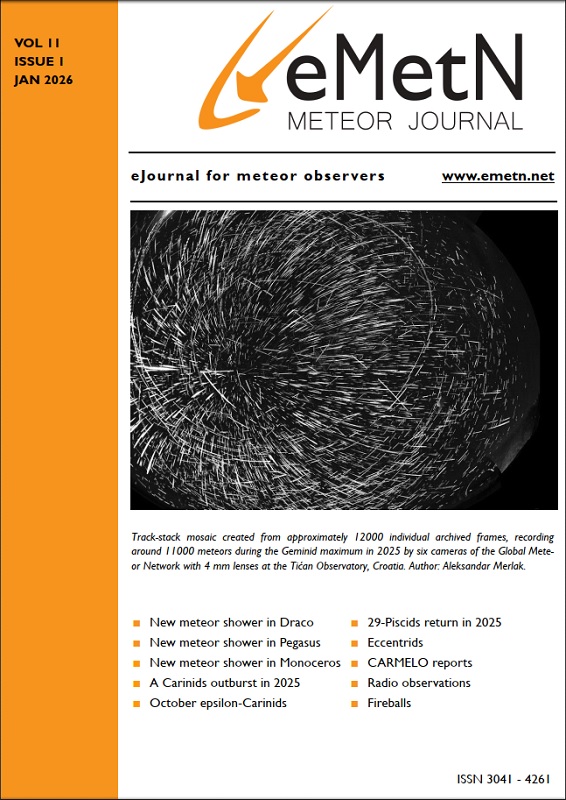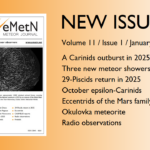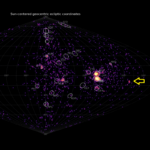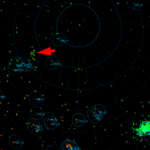During this period, the moon reaches its new phase on Saturday August 23rd. On that date it will be located near the sun and will be invisible at night. As the week progresses, the waxing crescent moon will enter the evening sky and will only slightly hamper meteor observing during the evening hours late in the week. The estimated total hourly rates for evening observers this weekend should be near 4 as seen from mid-northern latitudes (45N) and 3 as seen from tropical southern locations (25S). For morning observers, the estimated total hourly rates should be near 18 as seen from mid-northern latitudes (45N) and 11 as seen from tropical southern locations (25S). The actual rates seen will also depend on factors such as personal light and motion perception, local weather conditions, alertness, and experience in watching meteor activity. Evening rates are slightly reduced during this period due to moonlight. Note that the hourly rates listed below are estimates as viewed from dark sky sites away from urban light sources. Observers viewing from urban areas will see less activity as only the brighter meteors will be visible from such locations.
The radiant (the area of the sky where meteors appear to shoot from) positions and rates listed below are exact for Saturday night/Sunday morning August 23/24. These positions do not change greatly day to day so the listed positions may be used during this entire period. Most star atlases (available online and at bookstores and planetariums) will provide maps with grid lines of the celestial coordinates so that you may find out exactly where these positions are located in the sky. I have also included charts of the sky that display the radiant positions for evening, midnight, and morning. The center of each chart is the sky directly overhead at the appropriate hour. These charts are oriented for facing south but can be used for any direction by rotating the charts to the desired direction. A planisphere or computer planetarium program is also useful in showing the sky at any time of night on any date of the year. Activity from each radiant is best seen when it is positioned highest in the sky (culmination), either due north or south along the meridian, depending on your latitude. Radiants that rise after midnight will not reach their highest point in the sky until daylight. For these radiants, it is best to view them during the last few hours before dawn. It must be remembered that meteor activity is rarely seen at its radiant position. Rather they shoot outwards from the radiant, so it is best to center your field of view so that the radiant lies toward the edge and not the center. Viewing there will allow you to easily trace the path of each meteor back to the radiant (if it is a shower member) or in another direction if it is sporadic. Meteor activity is not seen from radiants that are located far below the horizon. The positions below are listed in a west to east manner in order of right ascension (celestial longitude). The positions listed first are located further west therefore are accessible earlier in the night while those listed further down the list rise later in the night.
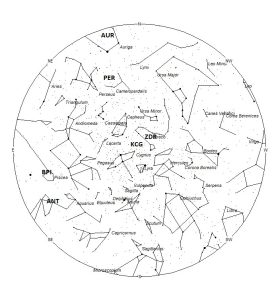
Radiant Positions at 22:00 LST
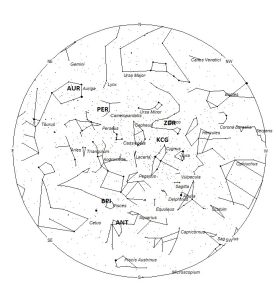
Radiant Positions at 01:00 LST
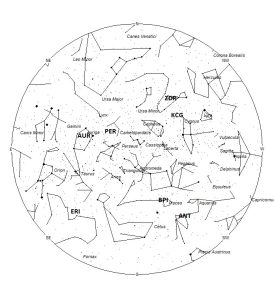
Radiant Positions at 04:00 LST
These sources of meteoric activity are expected to be active this week
.
The zeta Draconids (ZDR) were discovered by Zdenek Sekanina in his study of meteor streams using radio methods. This stream is active from August 12-September 5 with maximum activity occurring on August 26. The radiant is currently located at 17:40 (265) +63, which places it in southeastern Draco, 5 degrees southeast of the 3rd magnitude star known as zeta Draconis. This radiant is best placed near 20:00 local summer time (LST), when it lies on the meridian and is located highest in the northern sky. With an entry velocity of 22 km/sec., the average zeta Draconid meteor would be of medium-slow velocity. Rates this week are expected to be less than 1 no matter your location. Due to the high northern declination these meteors are difficult to observe from the southern hemisphere. This position is close to that of the kappa Cygnid radiant so care should be taken to differentiate between these meteors. These meteors are synonymous with the August Draconids (AUD).
The kappa Cygnids (KCG) are active from July 23-August 27, with maximum occurring on August 14th. The radiant is currently located at 19:24 (291) +58. This area of the sky is located in extreme southeastern Draco, 5 degrees north of the 4th magnitude star known as kappa Cygni. To best see these meteors face northward near 2200 LST when it lies on the meridian and is located highest in the sky. With a high northern declination, these meteors are difficult to view from the southern hemisphere. Expected hourly rates this week are less than 1 no matter your location. With an entry velocity of 24 km/sec., the average meteor from this source would be of medium-slow velocity.
The large Anthelion (ANT) radiant is currently centered at 22:52 (343) -07. This position lies in central Aquarius, near the spot occupied by the 4th magnitude star known as lambda Aquarius. This radiant is best placed near 01:00 LST when it lies on the meridian and is highest in the southern sky. Rates at this time should be near 3 no matter your location. With an entry velocity of 30 km/sec., the average Anthelion meteor would be of medium-slow velocity.
The August beta Piscids (BPI) were first mentioned by Luigi G. Jacchia in his book The Moon, Meteorites and Comets. The BPI’s’s are active from July 28-September 17, with the peak occurring on the August 22nd. The radiant currently is located near 23:40 (355) +06. This area of the sky is located in western Pisces near the spot occupied by the 4th magnitude star known as iota Piscium. To best see these meteors look in the southern sky near 0300 LST, when it lies on the meridian and is located highest in the sky. Hourly rates at this time should be near 1 no matter your location. With an entry velocity of 38m/sec., the average meteor from this source would be of medium velocity. These meteors are also known as the Northern delta Aquariids (NDA).
The eta Eridanids (ERI) are active from a radiant near 03:44 (056) -08. This position lies in northern Eridanus, 2 degrees north of the 4th magnitude star known as Rana (delta Eridani). This source is active until September 10th. Current rates are expected to be less than 1 per hour no matter your location. These meteors are best seen during the last dark hour prior to dawn when the radiant lies highest above the southeastern horizon in a dark sky. With an entry velocity of 64 km/sec., the average meteor from this source would be of swift speed.
The Perseids (PER) are active from July 17 through August 29, with maximum activity occurring on August 13. The radiant is currently located at 04:20 (065) +60. This position lies in southwestern Camelopardalis, 5 degrees west of the 4th magnitude star known as beta Camelopardalis. This area of the sky is best placed for viewing during the last dark hour before dawn when it lies highest in the northeastern sky. Current rates are expected to be near 1 as seen from the northern hemisphere and less than 1 as seen from south of the equator. With an entry velocity of 59 km/sec., the average meteor from this source would be of swift velocity. Viewers in the southern hemisphere have a limited view of this shower as the radiant only rises just before dawn.
The first members of the Aurigids (AUR) should appear on Friday morning August 27th. These meteors are active from August 29-September 2 with a peak on August 31st. On the 29th the radiant will be located at 05:44 (086) +38. This position lies in central Auriga, 3 degrees northwest of the 3rd magnitude star known as Mahasim (theta Aurigae A). This area of the sky is best placed for viewing during the last dark hour before dawn when it lies highest in the northeastern sky. Current rates are expected to be near 1 as seen from the northern hemisphere and less than 1 as seen from south of the equator. With an entry velocity of 66 km/sec., the average meteor from this source would be of swift velocity.
Sporadic meteors are those meteors that cannot be associated with any known meteor shower. All meteor showers are evolving and disperse over time to the point where they are no longer recognizable. Away from the peaks of the major annual showers, these sporadic meteors make up the bulk of the activity seen each night. As seen from the mid-northern hemisphere (45N) one would expect to see during this period approximately 12 sporadic meteors per hour during the last hour before dawn as seen from rural observing sites. Evening rates would be near 3 per hour. As seen from the tropical southern latitudes (25S), morning rates would be near 7 per hour as seen from rural observing sites and 2 per hour during the evening hours. Locations between these two extremes would see activity between these listed figures. Evening rates are slightly reduced due to moonlight.
The list below offers information in tabular form of the active showers that I feel are within reach of the visual observer to discern. Hourly rates are often less than one, so these sources are rarely listed as visual targets in most meteor shower lists. If you are like me and wish to associate as many meteors as possible with known sources, then you will appreciate these listings. Before claiming to have seen meteors from these class IV showers, you should attempt to determine if these meteors actually belong to them and are not chance alignments of sporadic meteors. You can note parameters such as duration, length, radiant distance and the elevation of each meteor to help compute the probability of shower association. It should be remembered that slow meteors can be seen from fast showers, but fast meteors cannot be produced from slow showers. Slower showers are those with velocities less than 35/km per second. Slow meteors can appear from fast showers when they appear close to the radiant or low in the sky. The table located on page 22 of the IMO’s 2025 Meteor Shower Calendar is a big help in aiding in the identification of meteors. If you record the length and duration of each meteor, you can use this chart to check the probability of the meteor belonging to a shower of known velocity. If the angular velocity is similar to the figure in the table, then your meteor probably belongs to that shower. Recognizing meteors from obscure showers is certainly not for the beginning meteor observer as it takes many hours to get a feel of what you are seeing. It is our hope that you will advance beyond watching meteors as a fireworks display and will want to help us expand our knowledge of the heavenly bodies we encounter in the skies above by classifying each meteor you see. Rates and positions in the table are exact for Saturday night/Sunday morning.
| SHOWER | DATE OF MAXIMUM ACTIVITY | CELESTIAL POSITION | ENTRY VELOCITY | CULMINATION | HOURLY RATE | CLASS |
| RA (RA in Deg.) DEC | Km/Sec | Local Summer Time | North-South | |||
| zeta Draconids (ZDR) | Aug 26 | 17:40 (265) +63 | 22 | 21:00 | <1 – <1 | IV |
| kappa Cygnids (KCG) | Aug 14 | 19:24 (291) +58 | 24 | 23:00 | <1 – <1 | II |
| Anthelion (ANT) | – | 22:52 (343) -07 | 30 | 02:00 | 3 – 3 | II |
| August beta Piscids (BPI) | Aug 22 | 23:40 (355) +06 | 38 | 03:00 | 1 – 1 | IV |
| eta Eridanids (ERI) | Aug 04 | 03:44 (056) -08 | 64 | 07:00 | <1 – <1 | II |
| Perseids (PER) | Aug 13 | 04:20 (065) +60 | 59 | 08:00 | 1 – <1 | I |
| Aurigids (AUR) | Aug 31 | 05:44 (086) +38 | 66 | 09:00 | 1 – <1 | III |
You can keep track of the activity of these meteor showers as well as those beyond the limits of visual observing by visiting the NASA Meteor Shower Portal. You can move the sky globe to see different areas of the sky. Colored dots indicate shower meteors while white dots indicate sporadic (random) activity. The large orange disk indicates the position of the sun so little activity will be seen in that area of the sky.
Class Explanation: A scale to group meteor showers by their intensity:
- Class I: the strongest annual showers with Zenith Hourly Rates normally ten or better.
- Class II: reliable minor showers with ZHR’s normally two to ten.
- Class III: showers that do not provide annual activity. These showers are rarely active yet have the potential to produce a major display on occasion.
- Class IV: weak minor showers with ZHR’s rarely exceeding two. The study of these showers is best left to experienced observers who use plotting and angular velocity estimates to determine shower association. These weak showers are also good targets for video and photographic work. Observers with less experience are urged to limit their shower associations to showers with a rating of I to III.

